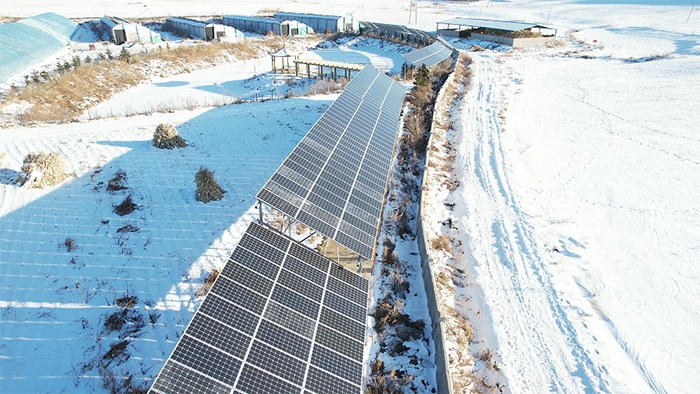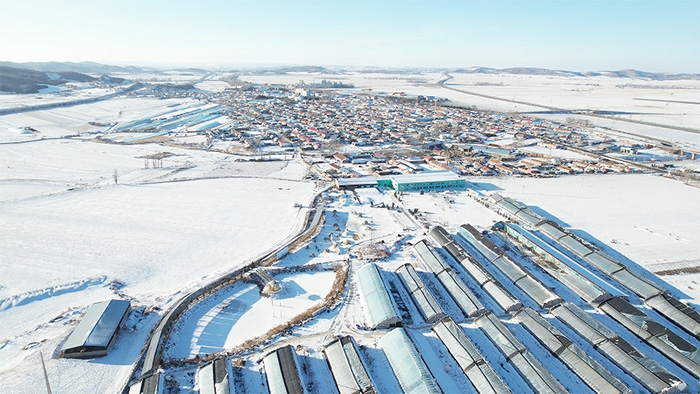As winter approaches, many regions across the country experience significant drops in temperature and snowfall, which pose more challenging operational conditions for photovoltaic (PV) power stations. Winter maintenance is essential to ensure PV power stations' safe and stable operation and maximize electricity generation efficiency. Home Power Inverter will provide a detailed overview of the key considerations and measures for winter operation and maintenance, covering modules, inverters, and other critical aspects of PV system management.
Winter Maintenance of PV Modules
PV modules are the core components of a photovoltaic power station, and their performance directly impacts the power generation efficiency of the station. During winter, modules are susceptible to dust, snow accumulation, and strong winds, so a series of maintenance measures are necessary.
- Dust Removal
Winter haze and dust issues are relatively severe, and these pollutants can accumulate on the PV module surface, reducing light absorption efficiency and leading to lower power output. Additionally, long-term shading may cause hot spots and mismatch issues.
Countermeasure: Regular cleaning of the module surface is crucial. It is recommended to use soft brushes and clean water for washing. The cleaning force should be moderate, avoiding the use of hard objects that could scratch the surface. Additionally, corrosive solvents should never be used. To prevent shading during the cleaning process, it is best to carry out dust removal work in the morning or evening when the light is weaker.

- Snow Removal
Winter snowfall can cover PV modules, blocking sunlight and severely affecting their power generation efficiency. Accumulated snow can also apply heavy pressure on the modules, increasing the risk of collapse.
Countermeasure: To mitigate the impact of snow accumulation, the following measures can be adopted: (1) Increase the tilt angle when installing the modules to reduce the accumulation speed of snow and prevent excessive snow buildup. (2) Ensure that the modules are elevated from the ground to prevent snow from accumulating underneath. (3) Use soft cleaning tools to gently push the snow off the module surface, avoiding scratches. (4) Never step on the modules for cleaning to prevent microcracks or damage. (5) Timely snow removal to avoid excessive snow accumulation that could lead to ice formation. (6) Consider using robotic snow removal systems to improve efficiency and safety.
- Wind Protection
Strong winds are common during winter and can cause PV modules to loosen or tilt, thereby affecting the normal operation and power generation efficiency of the station.
Countermeasure: To cope with strong winds, reinforce the fastening of modules and frames. Maintenance personnel should regularly inspect PV installations, focusing on modules with loose blocks and addressing potential issues promptly. It is also recommended to periodically check the stability of modules and frames to ensure they remain secure during windy conditions.
Winter Maintenance of Inverters
As the "brain" of the PV power station, inverters are responsible for converting the DC electricity generated by the PV modules into AC electricity and delivering it to the grid. Winter maintenance of inverters is equally important.
- Preventing Snow Accumulation
For outdoor-installed inverters, special attention should be given to preventing snow accumulation, especially on the top and bottom. Snow on the top can compromise the stability of the inverter's installation structure and cause severe icing of the casing, while snow on the bottom may bury the DC and AC interfaces and communication equipment, potentially triggering leakage current alarms or affecting communication.
Countermeasure: Use plastic or wooden shovels to promptly remove snow around the inverter to avoid damaging the casing or cables. After clearing the snow, check the stability of the wall on which the inverter is installed. Additionally, consider placing the inverter in a sheltered area to reduce the impact of snow.
- Frost on the Inverter Casing
During extremely low temperatures, frost may form on the inverter’s casing. While this typically doesn’t affect its normal operation significantly, excessive frost can impair heat dissipation and damage its appearance. Inverters from Inverter.com, for instance, feature an IP65 protection rating, making them highly resilient to extreme temperatures and harsh environments.
Countermeasure: To address frost buildup on the inverter casing, the following measures can be taken: (1) If there is little frost, allow it to naturally melt. (2) To prevent further frost accumulation, regularly clean the inverter casing of dust and dirt using a soft cloth. Avoid using rough cloths or chemical cleaners. (3) Check the surrounding environment for issues such as cold air flow, moisture, or standing water and address them appropriately. (4) Strengthen monitoring and maintenance of the inverter, regularly checking its operational status and heat dissipation.
- High Panel Voltage
In cold winter weather, the output voltage of the PV array may rise, which can affect the normal operation of the inverter. During design and installation, the low-temperature characteristics of the modules should be considered to ensure that the string voltage does not exceed the inverter’s input voltage range.
Countermeasure: To manage high panel voltage: (1) Reduce the number of modules in series to keep the voltage within the inverter’s input voltage range. (2) If the string voltage is within the specified range but the inverter still reports a high panel voltage warning, check whether the inverter settings and wiring are correct and investigate any other potential faults.

Other Winter Maintenance Considerations
In addition to modules and inverters, other critical areas need attention during winter maintenance:
- Fire Prevention: Winter is a season with dry, flammable vegetation, increasing the risk of fires. Thus, fire prevention at PV power stations should not be overlooked. Ensure that no flammable materials are stored near the inverter, and regularly check the insulation on exposed wires and cables to prevent fire hazards due to aging, cracking, or damage. Additionally, strengthen inspection and protection to detect and address potential fire risks.
- Monitoring Inverter Data: Modern inverters are equipped with intelligent communication and monitoring functions. By reviewing the monitoring data, it is possible to gain real-time insights into the inverter's operation and performance. Thus, it is crucial to regularly check the inverter's monitoring data. During these checks, confirm that the inverter’s communication data is normal and that the power generation capacity of similar inverters is consistent. If significant discrepancies are found in the power output of a particular inverter, investigate and resolve the issue promptly.
- Regular Cable Inspections: Winter temperatures can cause cables to age, crack, or develop leakage issues. These faults can not only affect the normal operation of the PV station but also pose safety risks. Therefore, regularly check the reliability of cable connections and whether there is any aging or damage. Any issues found should be addressed promptly to ensure the safety and reliability of cable connections.
- Regular Distribution System Inspections: Winter is a peak electricity consumption period, and the safe and stable operation of the distribution system is crucial for the PV station's power generation efficiency and safety. Regularly inspect electrical equipment such as circuit breakers and leakage protectors to ensure they are functioning correctly. Additionally, strengthen patrols and monitoring of the distribution room to detect and address potential safety hazards on time.
Conclusion
Winter is a critical period for the operation and maintenance of photovoltaic power stations. To ensure the safe and stable operation of PV power stations and maximize power generation efficiency, a series of maintenance measures must be implemented. These include dust removal, snow removal, and wind protection for modules; snow prevention, frost control, and high voltage management for inverters; as well as fire prevention, monitoring data checks, cable inspections, and distribution system checks.
By carrying out thorough and detailed maintenance work, Home Power Inverter believes that it is possible to overcome the challenges posed by low solar angles, short daylight hours, and strong winds during winter, thereby improving the power generation efficiency and stability of the PV station. Additionally, this approach helps extend the lifespan of the PV station and reduce maintenance costs. Therefore, PV station operators should pay close attention to winter maintenance to ensure the safe and efficient operation of the station.
